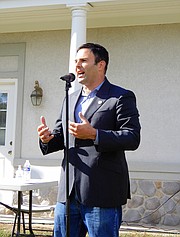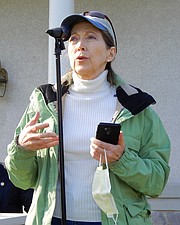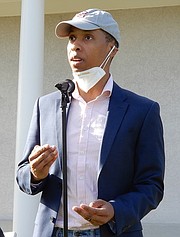Upset that neither Fairfax County’s Board of Supervisors, nor VDOT, seem to care about residents’ objections to proposed “fixes” for Braddock and Old Lee Roads, Kathleen Leggette hosted her own, town-hall meeting. Held Oct. 18, in her Sully Estates yard off Braddock Road, some 60 people attended, including Del. Dan Helmer (D-40) and State Sen. Dave Marsden (D-37).
VDOT’s plan would send a new road through her property – in a 100-year floodplain, the Chesapeake Watershed and a Resource Protection Area – and endanger the wildlife and environment there. So VDOT’s so-called “interim” road would cause permanent damage to her land.
“Civic engagement is important in a democracy,” Leggette told the politicians. “And your coming here makes a statement that our voices should be heard.”
Helmer said the matter deserves more than “a one-way dialogue with just VDOT talking.” And Marsden, chairman of the senate’s Transportation Committee, said VDOT needs to work with the residents in person “so you can make sure your government is doing right by you, the people living in this community.”
“In Fairfax County, we’re currently seeing policies representing only one segment – developers,” said resident Bob Petrine. “Citizens are here today to protest this. Kathy Smith leads the Supervisors’ powerful, Land-Use Policy Committee – and is, literally, the fox in the henhouse. The public process has been virtually nil and an insult to transparency and decency. The Supervisors are flaunting the will of the people and the health of the environment.”
RAISED IN VIRGINIA RUN, Marlena Carr wanted to know how VDOT would manage the resulting stormwater-runoff increase to have the least impact on the environment. And Kay Kimball, who lives on Braddock, said, “Loudoun wants to expand it to four lanes, all the way to Route 28 in Manassas, and I’m concerned about the impact on the trails and our real-estate values.”
Sully Estates’ Grant Cates said he often sees drivers cross the yellow lines on the S curve and suggested extending it at its apex to go into Rock Hill Park. “Then do a roundabout there to smooth traffic flow into Westfields, plus 2/10 of a mile of a new road,” he explained. “It would reduce congestion on Old Lee and get the jughandle off this property.”
Virginia Run’s Jim Hart was most concerned about the project’s environmental impact. “We’re just downhill from the largest stand of a globally rare, oak and hickory forest in Virginia,” he said. “Environmental-impact studies should be done first. The Cub Run Stream contains the threatened wood turtle, and there’d be massive disturbance in the floodplain, uphill from the Occoquan.”
Stressing that the CTB needs stakeholder buy-in for projects to move forward, he urged residents most affected by this one to make their voices heard. He also said VDOT’s plan would result in more traffic – and large trucks – from Loudoun on Braddock. “The two-lane segment of Braddock was never intended to be the main way between Loudoun and Route 28 in Centreville,” said Hart. “These neighborhoods weren’t meant to be commuter neighborhoods.”
Steve Chulick of Virginia Chase lives near another tricky curve on Braddock. “I’ve seen accidents there that came close to the houses,” he said. “And improving the S curve will bring more traffic onto my section of Braddock, too.”
Centreville’s Chris Terpak-Malm said VDOT representatives “take comments but aren’t really listening. How could this be better than simple stop signs and a stoplight? The land in Rock Hill Park isn’t pristine parkland. And if they spend $16 million to do this project, they’re never going to do the Comp Plan [alignment that goes through that park].”
Sierra Club member Ann Bennett wanted something “less detrimental” chosen. “Environmental concerns are too often the last priority,” she said. “More concrete and asphalt aren’t the answer.”
“Loudoun wants to erase all the hard work the Planning Commission did to protect the environment and endangered species in Cub Run,” said former Sully District Planning Commissioner John Litzenberger. “Cut off the funding for this, until we can get it right.”
“COVID has become our Supervisors’ best friend,” said Centreville’s Carol Hawn. “They’re making decisions in developers’ best interests and not listening to us. Braddock shouldn’t be widened into a four-lane thoroughfare just so Loudoun can quickly get to Route 28. That’s why the Comp Plan is the way it is – but the Supervisors are just ignoring it.”
Beecher Brown, who lives adjacent to Braddock, said, “We see no benefit here. Keep Loudoun drivers on Route 50.” And Sully District Council member Sheila Dunheimer worried that this project could adversely affect people’s private wells.
Resident Jehanne Arslan questioned Fairfax County’s leadership. “Once you lose your clean water, where do you go?” she asked. “Why wouldn’t the Supervisors want to protect areas like this that have been previously set aside for protection?”
Leggette read comments from Sully District Council’s Jay Johnston. “Our rural way of life in Western Fairfax County is under attack, due in part to politicians who care more for their own legacy than for the residents of this region,” he wrote. “We don’t have to stand by and watch every square inch of [our land] turned into residential neighborhoods or paved with roads allowing traffic from other regions to flow freely through Western Fairfax County.”
Johnston said the Supervisors and Planning Commissioners have used the pandemic for “more aggressive political maneuvering and misguided decisions,” enabling them to rush land-use cases to approval. They’ve “strategically eliminated citizens’ voices,” he wrote, by holding online meetings and making important decisions virtually, “knowing citizens are less likely to join such meetings.”
He said the road changes will alter Braddock’s rural character forever and negatively impact residents living along that road. “[VDOT] plans to take private land, raising the road above the floodplain, right where you’re standing today,” wrote Johnson. “And affected residents haven’t been able to speak at public hearings about the insurmountable traffic and destruction of habitat [it would cause].”
Furthermore, he stressed, “We recognize the paramount importance of protecting the Occoquan Watershed and upholding Fairfax County’s environmental policies in its Comprehensive Plan. We’ve long supported protecting residential neighborhoods from development impacts, including traffic, stormwater, noise, and other detrimental effects, as well as protecting wildlife and the environment.”
JOHNSON WANTS the Supervisors to withdraw their funding request, reconsider their vote for the jughandle, hold a public hearing in the Government Center and conduct an environmental-impact study. “Billions were spent modifying Route 50 as the primary route for Loudoun traffic coming east,” he wrote, adding that the county should stick with the road realignment already in its Comprehensive Plan.
Leggette also read a letter from resident Daniel Mays, saying, “This road, so close to the Cub Run Stream – protected by law from construction – would endanger the water. And Rock Hill Park doesn’t have the engineering challenges the jughandle does, so it shouldn’t be more expensive. Ban trucks at the S curve and put a stop sign at Braddock and Old Lee, instead.”
Earlier, Leggette used a rope to trace the path of VDOT’s proposed road through her land. “It’s just 20-24 inches from the stream and 5 feet below the [current] road,” she said. It’s not logical and makes no engineering sense. A transportation engineer I consulted said VDOT really underestimated the S curve.
“It’ll have to take Braddock Road land after the Pleasant Valley roundabout, to the S curve, downhill and from several other properties because it’s too steep and won’t work. This ‘temporary’ road is supposed to last 20 years; but by the time they do the design studies and re-engineer the road, we’ll have spent $16 million for a road that’ll last 10 years.”
While noting VDOT also has to be concerned about Loudoun, Sen. Marsden said, “Probably your best argument is the environmental one. I’m concerned that we’re putting that stream in jeopardy. We need to have a meeting like this directly with VDOT and see what we can do in the state legislature to possibly exercise influence. Then, hopefully, Del. Helmer and I can sit down with the Supervisors and hammer out something more workable.”





